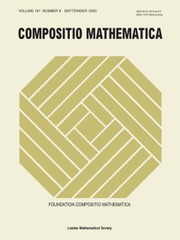Article contents
Approximation forte pour les variétés avec une action d’un groupe linéaire
Published online by Cambridge University Press: 08 March 2018
Abstract
Let  $G$ be a connected linear algebraic group over a number field
$G$ be a connected linear algebraic group over a number field  $k$ . Let
$k$ . Let  $U{\hookrightarrow}X$ be a
$U{\hookrightarrow}X$ be a  $G$ -equivariant open embedding of a
$G$ -equivariant open embedding of a  $G$ -homogeneous space
$G$ -homogeneous space  $U$ with connected stabilizers into a smooth
$U$ with connected stabilizers into a smooth  $G$ -variety
$G$ -variety  $X$ . We prove that
$X$ . We prove that  $X$ satisfies strong approximation with Brauer–Manin condition off a set
$X$ satisfies strong approximation with Brauer–Manin condition off a set  $S$ of places of
$S$ of places of  $k$ under either of the following hypotheses:
$k$ under either of the following hypotheses:
(i)
 $S$ is the set of archimedean places;
$S$ is the set of archimedean places;(ii)
 $S$ is a non-empty finite set and
$S$ is a non-empty finite set and  $\bar{k}^{\times }=\bar{k}[X]^{\times }$.
$\bar{k}^{\times }=\bar{k}[X]^{\times }$.
The proof builds upon the case  $X=U$ , which has been the object of several works.
$X=U$ , which has been the object of several works.
Soit  $G$ un groupe linéaire connexe sur un corps de nombres
$G$ un groupe linéaire connexe sur un corps de nombres  $k$ . Soit
$k$ . Soit  $U{\hookrightarrow}X$ une inclusion
$U{\hookrightarrow}X$ une inclusion  $G$ -équivariante d’un
$G$ -équivariante d’un  $G$ -espace homogène
$G$ -espace homogène  $U$ à stabilisateurs connexes dans une
$U$ à stabilisateurs connexes dans une  $G$ -variété lisse
$G$ -variété lisse  $X$ . On montre que
$X$ . On montre que  $X$ satisfait l’approximation forte avec condition de Brauer–Manin hors d’un ensemble
$X$ satisfait l’approximation forte avec condition de Brauer–Manin hors d’un ensemble  $S$ de places de
$S$ de places de  $k$ dans chacun des cas suivants :(i)
$k$ dans chacun des cas suivants :(i)
(i)  $S$ est l’ensemble des places archimédiennes ;
$S$ est l’ensemble des places archimédiennes ;
(ii)  $S$ est un ensemble fini non vide quelconque, et
$S$ est un ensemble fini non vide quelconque, et  $\bar{k}^{\times }=\bar{k}[X]^{\times }$.
$\bar{k}^{\times }=\bar{k}[X]^{\times }$.
La démonstration utilise le cas  $X=U$ , qui a fait l’objet de divers travaux.
$X=U$ , qui a fait l’objet de divers travaux.
Information
- Type
- Research Article
- Information
- Copyright
- © The Author 2018
References
- 9
- Cited by

